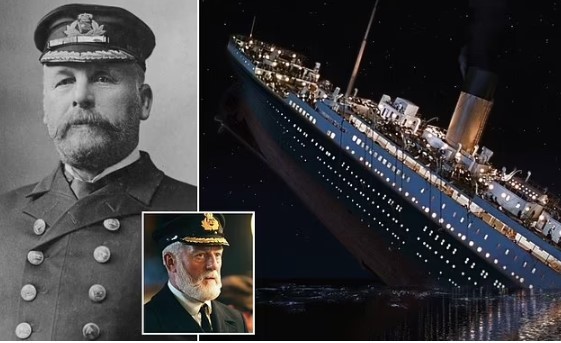Fabulous
New Book Reveals Truth About Titanic Captain’s Final Moments
New Book Challenges Titanic Myth: Captain Edward Smith's Final Moments Reconsidered.

For decades, audiences around the world have embraced a familiar and tragic image of Titanic’s Captain Edward John Smith: standing stoically on the bridge, gripping the ship's helm as icy Atlantic waters crash through the windows—his final act of heroism immortalized in James Cameron’s 1997 blockbuster. But a newly published book may change everything we thought we knew about that fateful night.
In Titanic Legacy: The Captain, The Daughter and The Spy, author Dan E. Parkes meticulously pieces together the true final moments of the Titanic’s famed commander. Drawing on firsthand accounts, official inquiries, and long-forgotten newspaper headlines, Parkes sets out to separate myth from fact—challenging a long-standing and often overlooked narrative: that Captain Smith may have taken his own life during the disaster.
A Darker Version of History Emerges
Three days after the Titanic tragedy on April 15, 1912, the Los Angeles Express ran a shocking headline: “Captain E.J. Smith shot himself.” Just a day later, Britain’s Daily Mirror echoed the claim: “Captain Smith Shoots Himself on the Bridge.”
In the aftermath of the disaster, rumors spread rapidly. Survivors whispered of ignored iceberg warnings, excessive speed, and even drunken behavior on Smith’s part. Many reports—often unverified—cast a shadow over the 62-year-old captain, once considered the White Star Line’s most esteemed officer and the highest-paid captain in the world.
For Smith’s grieving widow, Eleanor, and their seven-year-old daughter, Mel, the allegations added a cruel burden to their personal tragedy.
Separating Rumor from Reality
Parkes, however, believes it’s time to set the record straight. In Titanic Legacy, he argues that Smith did not die by suicide but either drowned or succumbed to hypothermia alongside 1,495 others. He dismisses the early tabloid reports as sensationalist fiction and criticizes their long-standing impact on the Captain’s legacy.
“It was character assassination, plain and simple,” Parkes writes, emphasizing how the unsupported suicide claims tarnished Smith’s memory for generations and devastated his family.
Indeed, Parkes provides compelling reasons to doubt the rumors. Although some survivors recalled hearing gunshots during the ship’s final moments, Parkes suggests those shots were more likely fired by officers attempting to manage the panicked crowds—not the sound of the Captain turning a weapon on himself.
Eyewitnesses Tell a Different Story
Several credible survivors claimed to have seen Captain Smith alive and composed during the ship’s final descent. Among them was Robert Williams Daniel, a 27-year-old banker and first-class passenger, who told the New York Herald that he saw the Captain calmly standing on the bridge as the ocean rose to his waist and finally engulfed him.
“He died a hero,” Daniel declared.
Frederick Dent Ray, a first-class steward, testified at a U.S. inquiry that Smith's personal steward, Arthur Paintin, was last seen beside the Captain on the bridge.
Another powerful recollection came from cook Isaac Maynard, who said in court testimony: “I saw Captain Smith washed from the bridge and afterwards saw him swimming in the water. He was still fully dressed, with his peak cap on.” According to Maynard, the Captain declined help from others clinging to a raft and shouted, “Look after yourselves, boys.”
Such testimonies contradict the notion of suicide and instead portray Smith as the honorable mariner he was believed to be—a man who accepted his fate and focused on saving others.
Accounts of Heroism
Parkes also explores claims that Smith went beyond mere stoicism. Some reports suggest he even tried to rescue others, including infants, while sacrificing his own chance at survival.
Frederick Harris, a fireman on board, told The Western Daily Mercury that he saw Smith place a baby on a raft before disappearing into the sea. George Brereton, a conman traveling under an alias, claimed to witness the Captain swimming toward the sinking ship after handing a child to a lifeboat—choosing to return to the doomed vessel rather than be saved.
These stories, though sometimes attributed to questionable figures, add to a growing body of narratives that support Parkes’ central argument: that Smith's final actions were gallant, not cowardly.
Debunking the Speeding and Drinking Myths
In addition to dispelling suicide rumors, Parkes also questions the widely held belief that Smith recklessly pushed the Titanic to excessive speeds. He finds no concrete evidence of the Captain ignoring iceberg warnings or behaving irresponsibly in the hours before the disaster.
Likewise, claims of Smith drinking on duty—also circulated in survivor accounts—are refuted in Parkes’ research. One exception involves a shared drink with millionaire passenger Frederick Hoyt, who described having a stiff drink with Smith shortly before jumping overboard. However, Parkes suggests this was more a gesture of solidarity than evidence of inebriation.
A Legacy Restored
Smith’s nickname, “The Millionaire’s Captain,” reflected his popularity among elite passengers, who trusted his judgment and admired his calm authority. That image, Parkes argues, is far more consistent with the Captain’s final moments than the darker tales of cowardice that haunted his legacy.
Interestingly, the Captain may have sensed his own fate. According to a story in the Chicago Tribune, Ada Murdoch, wife of First Officer William Murdoch, once expressed concerns over Titanic’s safety. Smith reportedly replied, “If the largest liner in the world sinks, I shall go with it.”
And so he did.
With Titanic Legacy, Dan E. Parkes challenges over a century of speculation and cinematic dramatization, offering a more human and heroic portrait of Edward John Smith. By sifting through survivor testimony, court records, and forgotten headlines, the book not only revisits one of history’s greatest maritime disasters but also seeks to restore dignity to a man who may have been unfairly maligned for more than 100 years.
As new generations continue to be captivated by the Titanic story, Parkes’ work stands as a timely reminder that the truth—often buried beneath myth and media—still matters.

Jennifer Lopez looks ageless in a towel in no-makeup video

Amanda Holden spanks her derriere and thanks Spanx

Amanda Holden shows off more than bargained as she dances around in her outfit of the day

Italian models Giulia Salemi and Dayane Mello looks glam

Meet Harley Cameron, the stunning model who went from a BKFC ring girl to become a pro wrestler and found love

GreenGirlBella, Rocks Emirates Stadium in Painted Home Kit

Amanda Holden calls herself a 'good girl' in white dress with 'cheeky' split

Mum slammed by parents after flashing thong in school run outfit

Lottie Moss makes jaws dropp as she shows off her flawless body







Comments
Written news comments are in no way https://www.showbizglow.com it does not reflect the opinions and thoughts of. Comments are binding on the person who wrote them.